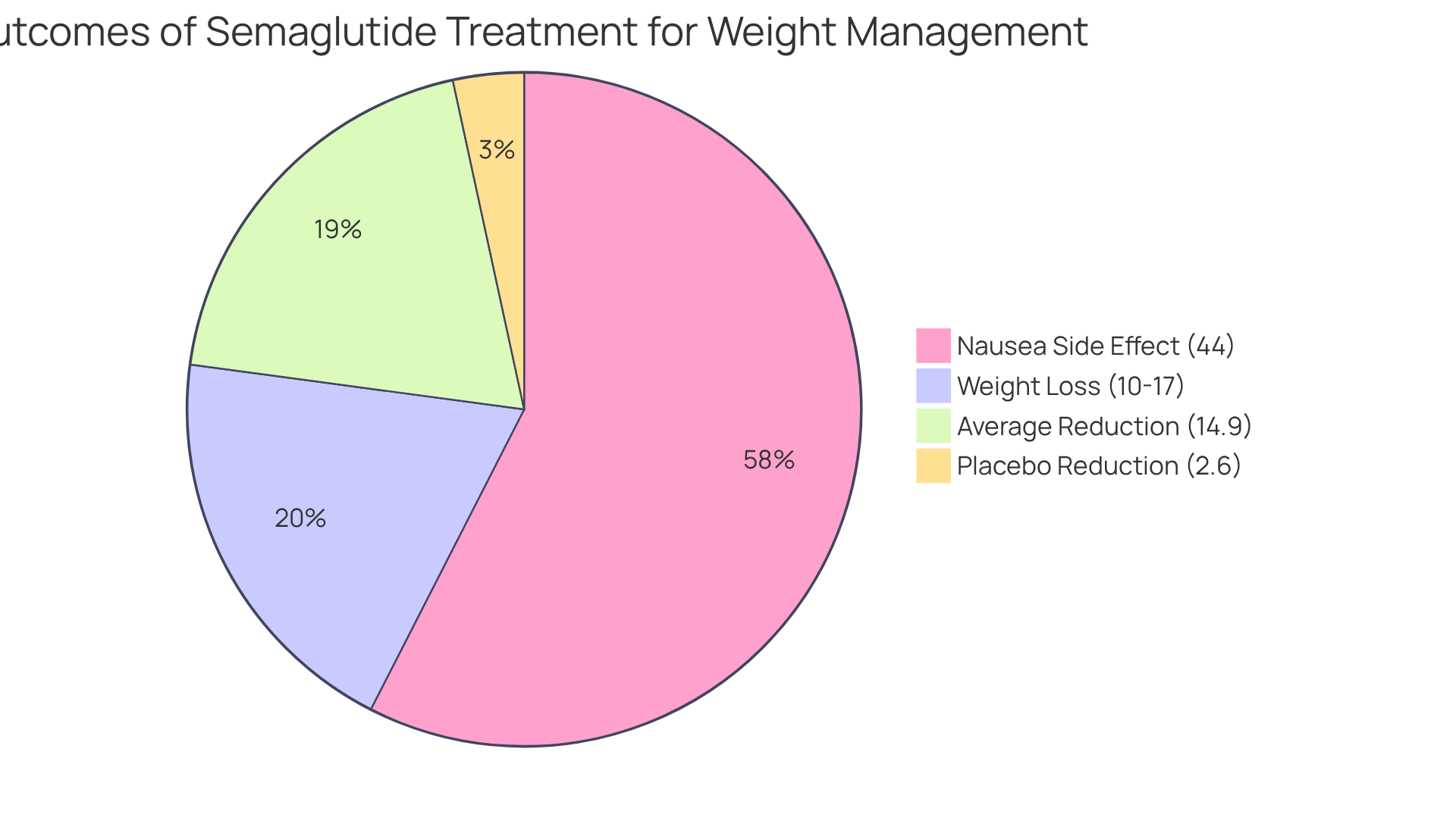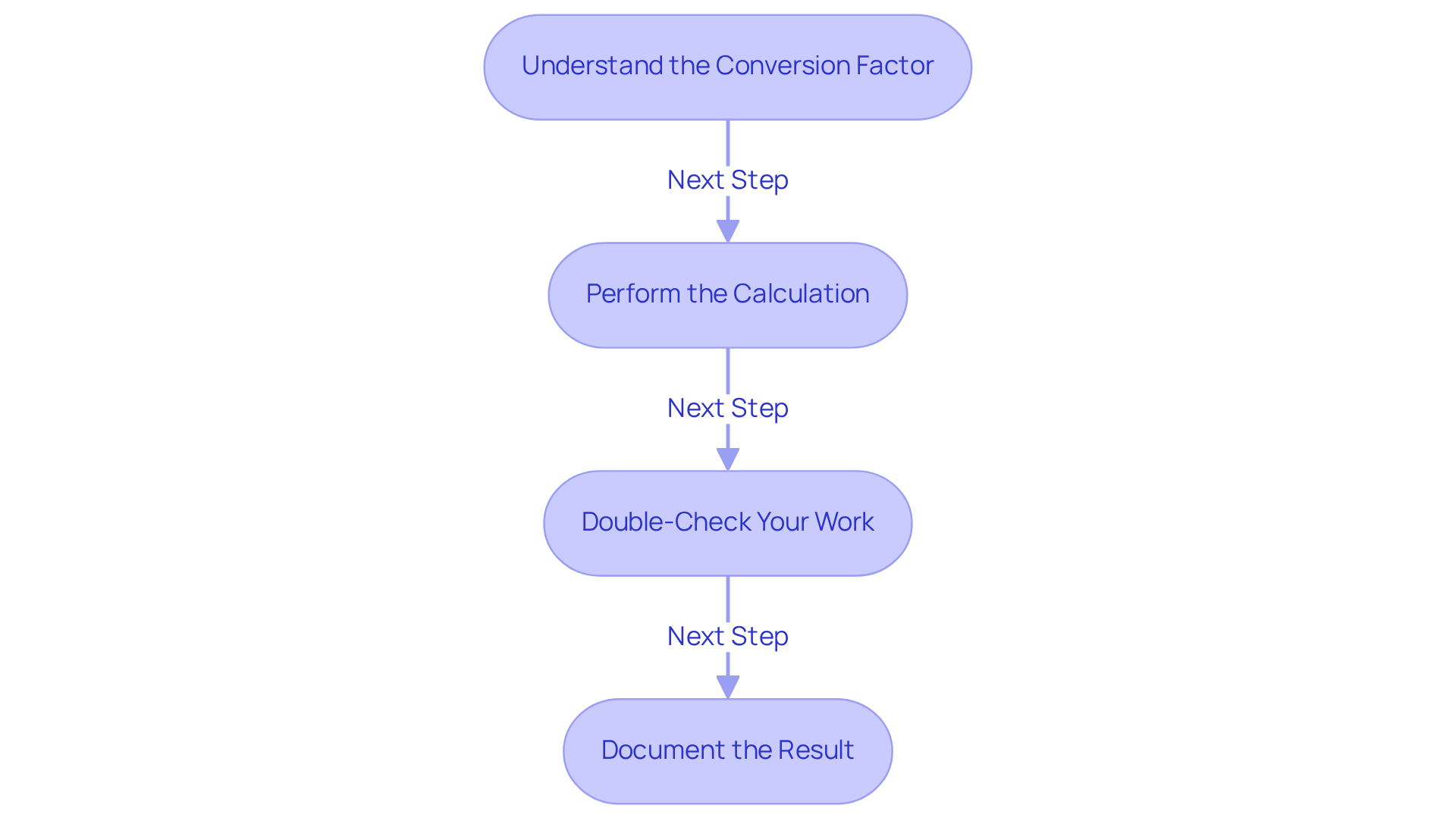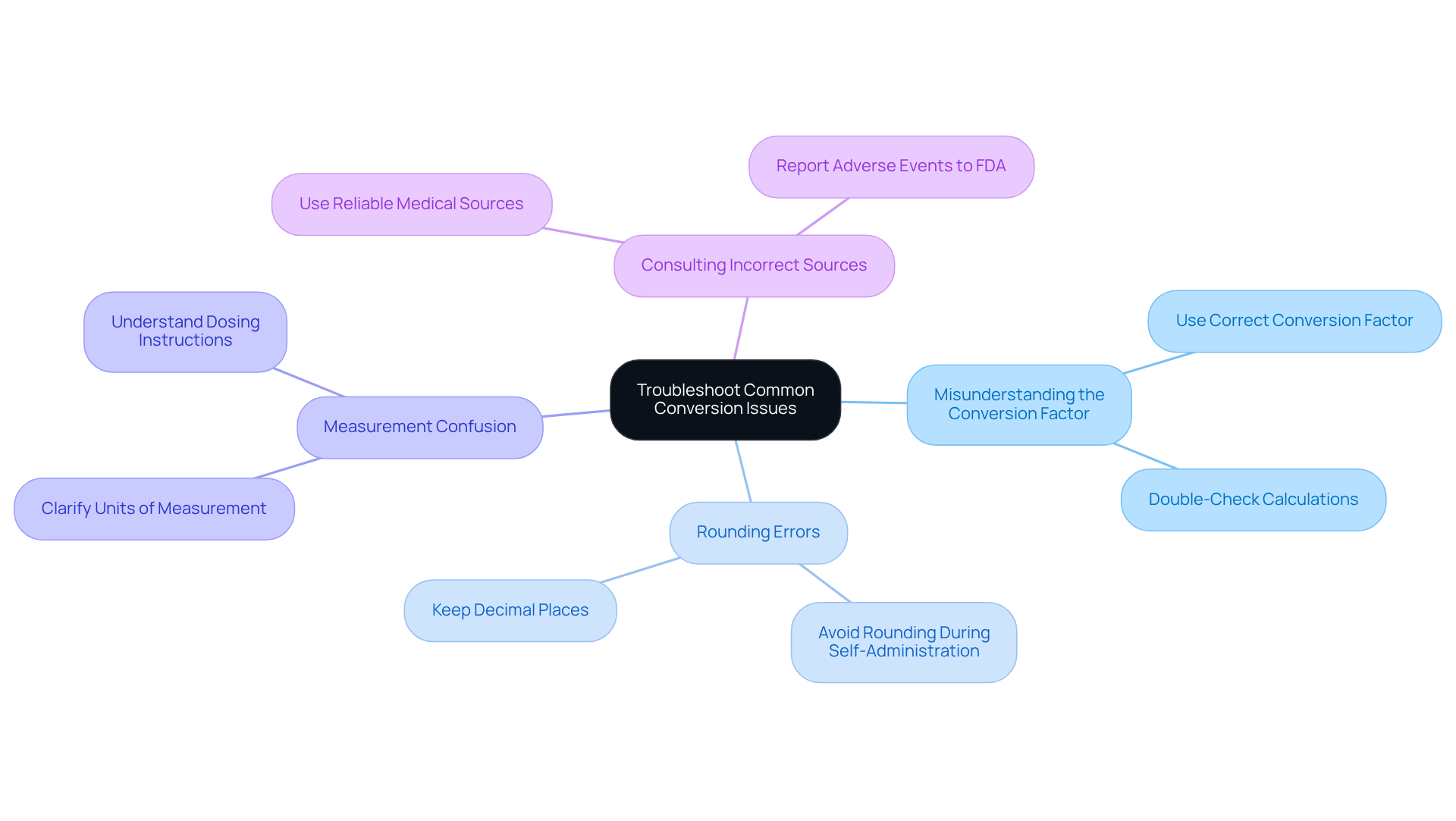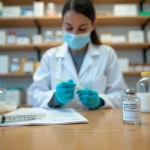Overview
This article thoughtfully addresses the conversion of 70 units of semaglutide to milligrams, clarifying that this equals 17.5 mg when using the conversion factor of 0.25 mg per unit. It’s important to understand this conversion, as accurate dosing plays a vital role in ensuring effective treatment outcomes.
We recognize that navigating these details can feel overwhelming, but rest assured, we’re here to guide you through the process. By following the straightforward calculation process outlined here, you can feel more confident in your treatment journey. Together, we can achieve your goals and support your health effectively.
Introduction
Understanding the intricacies of semaglutide can feel overwhelming for many, especially when it comes to managing dosages effectively. This medication, recognized for its role in weight loss and diabetes management, requires precise conversions to ensure you achieve optimal results. As you embark on this journey, you’ll discover the straightforward process of converting 70 units of semaglutide into milligrams—a crucial step in your treatment.
However, potential pitfalls may arise in the conversion process. How can you navigate these challenges to ensure safe and effective dosing? Together, we can explore these important steps and empower you on your path to wellness.
Understand Semaglutide: Purpose and Uses
Semaglutide is a medication designed to help manage body mass and treat type 2 diabetes, acting as a GLP-1 receptor agonist. By mimicking the GLP-1 hormone, it plays a vital role in controlling appetite and insulin release, which can lead to significant reductions in body mass and improved metabolic health. If you’re feeling overwhelmed by your weight loss journey, recent studies indicate that individuals using this medication can expect to lose about 10% to 17% of their initial body mass within a year, especially when combined with a balanced diet and regular exercise.
This dual action not only aids in reducing body mass but also enhances glycemic regulation, making it a supportive option for those facing obesity and diabetes challenges. In clinical studies, participants taking the medication saw an average reduction of 14.9%, a notable improvement compared to the 2.6% reduction in the placebo group. Additionally, real-world data reveals that approximately 77.1% of participants achieved at least a 5% reduction in body weight after 104 weeks of treatment, highlighting its effectiveness in practical settings.
However, it’s important to remember that this medication isn’t a standalone solution. Its effectiveness is maximized when paired with lifestyle changes. Healthcare professionals stress the significance of a comprehensive approach, combining medication with behavioral interventions for sustainable health outcomes. As Dr. Chance Miller emphasizes, “Clients appreciate the personalized attention from a dedicated care team,” reflecting our commitment to holistic health solutions.
While this medication can be effective, being aware of potential side effects is crucial. For instance, 44% of participants in clinical trials reported experiencing nausea as a side effect of Wegovy. Understanding the role of this medication, along with the supportive care we provide, empowers you on your journey to better health. Together, we can achieve your goals, and we’re here for you every step of the way.
Convert Units to Milligrams: Step-by-Step Process
Converting 70 units of semaglutide is how many mg is an important step in your weight loss journey. Let’s walk through this together, ensuring you feel confident in your understanding.
-
Understand the Conversion Factor: Semaglutide is typically administered in increments, with each increment equating to 0.25 mg. This means that to convert your units to milligrams, like determining 70 units of semaglutide is how many mg, you simply multiply the number of units by 0.25. It’s a straightforward process, but knowing this can help alleviate any confusion you might have.
-
To perform the calculation, you need to find out 70 units of semaglutide is how many mg: 70 units × 0.25 mg/unit = 17.5 mg. This clear result is a crucial part of managing your treatment effectively.
-
Double-Check Your Work: It’s always a good practice to verify your calculations. You can do this by reversing the process: 17.5 mg ÷ 0.25 mg/portion = 70 portions. Taking this extra step can provide peace of mind.
-
Document the Result: Keeping a record of your conversion is essential for future reference, especially as you manage your own dosing. Remember, precise dosing is vital for the effectiveness of your treatment, which can lead to an average weight reduction of 15% over a year and a half. If you have any concerns about dosage adjustments or potential gastrointestinal side effects, such as nausea or vomiting, please consult with healthcare professionals. We’re here for you, and together, we can achieve your goals.
Troubleshoot Common Conversion Issues
When converting semaglutide units to milligrams, such as figuring out 70 units of semaglutide is how many mg, it’s important to recognize some common challenges that many face.
-
Misunderstanding the Conversion Factor: Are you sure you’re using the correct conversion factor of 0.25 mg per item to determine 70 units of semaglutide is how many mg? Miscalculating this can lead to incorrect dosing, and we’ve seen cases where patients received doses five to twenty times higher than intended due to such miscalculations. It’s crucial to double-check this detail to ensure your safety.
-
Rounding Errors: Have you ever found yourself rounding numbers during self-administration? This can lead to significant inaccuracies, as patients often mistakenly draw up more than the prescribed dose. To avoid such errors, always keep as many decimal places as possible during calculations. Precision is key in your journey towards better health.
-
Measurement Confusion: Clarity is essential when converting quantities. Confusing units, such as the question ’70 units of semaglutide is how many mg’, can result in incorrect dosages, and we’ve heard stories of patients administering doses significantly higher than prescribed—like one patient who took five times the intended dose due to unclear instructions. Make sure you understand exactly what you’re converting to safeguard your health.
-
Consulting Incorrect Sources: Always turn to reliable medical sources or guidelines for conversion factors. Misinformation can lead to serious health risks. The FDA emphasizes the importance of reporting adverse events and medication mistakes, especially with compounded formulations. By using credible sources, you can avoid potential consequences and ensure your treatment is safe.
By acknowledging these frequent challenges and taking proactive steps to address them, you can greatly enhance the precision of your dosing. Remember, we’re here for you, and together, we can achieve your goals for safer and more effective treatment results.
Consult Healthcare Professionals for Safe Dosing
Before you start or adjust your semaglutide dosage, it’s crucial to consult a healthcare professional. They can offer personalized advice tailored to your health history, current medications, and your goals for weight loss. Let’s explore some important aspects together:
-
Personalized Dosing: Your healthcare provider is instrumental in finding the right dosage for you, ensuring both safety and effectiveness. Typically, the recommended starting dose for weight loss is 0.25 mg once a week, and it’s important to know how 70 units of semaglutide is how many mg can be adjusted based on your response.
-
Monitoring Progress: Regular check-ins with your healthcare provider are essential for tracking your journey. Research indicates that patients can lose an average of 14.9% of their body mass over 68 weeks when following a structured plan, underscoring the importance of ongoing support. This statistic highlights how effective this treatment can be when combined with professional guidance.
-
Addressing Concerns: If you experience side effects, like nausea—which affects 11-20% of users—or gastrointestinal issues, your healthcare provider is there to help with solutions and alternatives. Consistent communication is key to addressing any concerns and ensuring your treatment plan remains effective.
-
Integrating Lifestyle Changes: Healthcare professionals can also guide you in effectively combining medication with lifestyle changes, such as dietary adjustments and exercise, to enhance your weight loss results. Studies show that individuals who incorporate these changes alongside semaglutide, and understand that 70 units of semaglutide is how many mg, can achieve significant reductions in body mass, with many clients reporting decreases of up to 20% after six months, based on data from over 70,000 patients.
By prioritizing personalized care and regular monitoring, you can truly enhance your weight loss journey and work towards achieving sustainable health outcomes. Remember, we’re here for you, and together, we can achieve your goals.
Conclusion
Understanding the conversion of 70 units of semaglutide to milligrams is a vital step for anyone striving to manage their weight or diabetes effectively. This medication, acting as a GLP-1 receptor agonist, plays a significant role in appetite control and insulin regulation. When combined with lifestyle changes, it can lead to substantial weight loss. Clarity in dosage and its conversion empowers individuals on their health journeys, ensuring they receive the benefits of this treatment safely.
Throughout this article, we’ve explored key insights, including:
- The importance of the conversion factor of 0.25 mg per unit
- The significance of accurate calculations
- Common pitfalls to avoid during the conversion process
We emphasized that consulting healthcare professionals is essential for personalized dosing and monitoring. This approach can enhance the effectiveness of semaglutide and support your overall health goals.
Ultimately, taking proactive steps to understand semaglutide and its dosing can lead to improved health outcomes. By ensuring accurate conversions and seeking guidance from healthcare providers, you can navigate your weight loss journey more effectively. Embracing this knowledge not only fosters confidence but also encourages a holistic approach to health that integrates medication with lifestyle modifications for sustainable success. Together, we can achieve your goals, and remember, we’re here for you every step of the way.
Frequently Asked Questions
What is Semaglutide and what is its purpose?
Semaglutide is a medication designed to help manage body mass and treat type 2 diabetes. It acts as a GLP-1 receptor agonist, mimicking the GLP-1 hormone to control appetite and insulin release.
How effective is Semaglutide for weight loss?
Studies indicate that individuals using Semaglutide can expect to lose about 10% to 17% of their initial body mass within a year, especially when combined with a balanced diet and regular exercise.
What improvements have been observed in clinical studies with Semaglutide?
In clinical studies, participants taking Semaglutide saw an average reduction in body mass of 14.9%, compared to a 2.6% reduction in the placebo group. Additionally, about 77.1% of participants achieved at least a 5% reduction in body weight after 104 weeks of treatment.
Is Semaglutide effective on its own?
No, Semaglutide is not a standalone solution. Its effectiveness is maximized when paired with lifestyle changes, such as a balanced diet and behavioral interventions.
What are some common side effects of Semaglutide?
One common side effect reported in clinical trials is nausea, which was experienced by 44% of participants.
How can healthcare professionals support patients using Semaglutide?
Healthcare professionals emphasize a comprehensive approach that combines medication with behavioral interventions. They provide personalized attention and support to help clients achieve sustainable health outcomes.





















